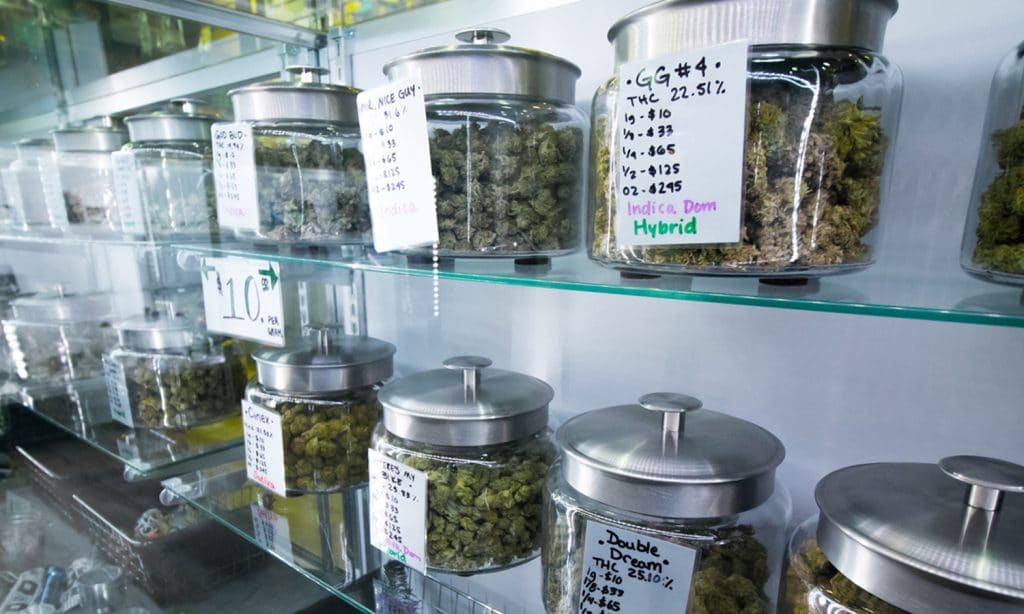Although recreational marijuana has not yet been legalized in Texas, Texas currently has a limited medical marijuana program established by the Texas Compassionate Use Act in 2015. The Texas Department of Safety (“DPS”) administers the Compassionate Use Program (“CUP”), including all licensing processes for dispensing organizations. In early 2023, DPS opened the full application process for dispensing organization licenses for the first time since licenses were initially awarded in 2017. The application window closed on April 28, 2023. Currently, only three dispensing organizations have been granted licenses by DPS to cultivate, process, and dispense low-THC cannabis to qualifying patients in Texas: Compassionate Cultivation, Fluent, and Surterra Texas. An announcement on the award of new licenses has not yet been made, and DPS has not confirmed how many licenses it expects to award. Pursuant to the Compassionate Use Act, DPS may only issue the number of licenses necessary to ensure reasonable statewide access to and availability of low-THC cannabis for patients registered in the compassionate-use registry.
Texas is a vertically integrated state, meaning that all dispensing organizations must cultivate, process, package, and dispense the medical marijuana from a single location. Currently, only low-THC cannabis is approved for dispensation under CUP, currently limited to 1% THC by dry weight. The program also has restrictions regarding qualifying conditions and does not include certain conditions, such as chronic pain. Applicants must also follow all other administrative and statutory rules of the Texas Administrative Code (“TAC”) Chapter 12, and Texas Health and Safety Code Chapter 487.
All applicants must pay a non-refundable application fee of $7,356.00 dollars. If approved, licensed dispensing organizations must pay a new licensing fee of $488,520.00 for a two (2) year period. A biennial renewal license costs $318,511.00. Dispensing organizations must also pay fees per employee to register them with DPS. Entry costs for Texas are very high compared to other states.
Application and Fee Requirements
To apply for a TCUP dispensing organization license in Texas, Applicants must complete and electronically submit the Dispensing Organization Application, all attachments, and the following corresponding Exhibits here:
- Exhibit A – Ownership documentation. Title 37, TAC §12.11(b)(1): Proof of ownership and current status, including but not limited to a current Certificate of Existence of Certificate of Authority from the Texas Office of the Secretary of State and a Certificate of Good Standing from the Texas Comptroller of Public Accounts.
- Exhibit B – Proof of required liability insurance. Title 37, TAC §12.11(b)(6): A certificate of insurance as proof of commercial general liability insurance coverage against claims of liability for damage to property of third parties and for personal injuries to third parties, including bodily injury, property damage, and product liability, with limits of:
- $1,000,000 each occurrence.
- $2,000,000 General Aggregate limit.
- $1,000,000 Product Liability.
If a certificate of insurance is not available at the time of application, a letter of intent to obtain required insurance may be submitted. Prior to final approval of a license, applicants will be required to provide a valid certificate of insurance.
- Exhibit C – Proof of the ability to secure the premises, resources, and employees necessary to operate as a dispensing organization. Title 37, TAC §12.11(b)(7)(B):
-
- Descriptions of all property’s applicant proposes to utilize to cultivate, process, and dispense low- THC cannabis, including ownership information for the properties.
- Descriptions of the methods proposed for the cultivation, processing, and dispensing of low THC cannabis.
- Descriptions of the types and locations of worker safety equipment and plans and procedures for complying with federal Occupational Safety and Health Administration (OSHA) regulations for workplace safety.
- A list of current and proposed staff, including, position, duties and responsibilities, and an organizational chart illustrating the supervisory structure of the dispensing organization.
- Description of the applicant’s proposed testing laboratory, and description of the proposed testing protocols and methods.
- A proposal establishing the ability to secure premises reasonably located to allow patient access through existing infrastructure.
- Exhibit D – Proof of the ability to maintain accountability of all raw materials, finished products, and any by products to prevent diversion or unlawful access to or possession of these substances. Title 37, TAC §12.11(b)(7)(C):
-
- Floor plan of each facility or proposed floor plans for proposed facilities, including:
- Locking options for all means of ingress and egress consistent with life safety requirements.
- Alarm systems.
- Video surveillance.
- Name, layout and function of each room; and
- Storage, including safes and vaults.
- Diversion prevention procedures.
- Emergency management plan.
- System for tracking source plant material throughout cultivation, processing, and dispensing.
- Inventory control system as required by Title 37, TAC §12.8.
- Policies and procedures for recordkeeping.
- Electronic vehicle tracking systems.
- Vehicle security systems.
- Methods of screening and monitoring employees.
- Employee qualifications and experience with chain of custody or other tracking mechanisms.
- Waste disposal plan.
- Recall procedures for any product that has a reasonable probability of causing adverse health consequences based on a testing result, patient reaction, or other reason.
- Access to specialized resources or expertise regarding data collection, security, and tracking
- Exhibit E – Proof of the financial ability to maintain operations for two (2) years from the date of application. Title 37, TAC §12.11(b)(7)(E):
-
- Description of applicant’s business organization, and corporate structure if applicable.
- List of all owners of any non-corporate applicant, or all shareholders of a corporate applicant.
- List of all individuals and entities with control over the applicant.
- Projected two (2) year budget.
- Description of available assets sufficient to support the dispensing organization activities.
- Exhibit F – Proof of the technical and technological ability to cultivate, process, and/or dispense low-THC cannabis, evidenced by experience in the areas listed below. Title 37, TAC §12.11(b)(7)(A):
-
- Cultivation, analytical organic chemistry and micro-biology; and analytical laboratory methods.
- Patient education and interaction, and the handling of confidential information including familiarity with the requirements of the Health Insurance Portability and Accountability Act (HIPAA).
- Exhibit G – Proof of infrastructure reasonably located to dispense low-THC cannabis to registered patients. Title 37, TAC §12.11(b)(7)(D):
-
- Map showing the location of the applicant’s proposed dispensing facilities with streets; property lines; buildings; parking areas; outdoor areas, if applicable; fences; security features; fire hydrants, if applicable; and access to water and sanitation systems.
- Floor plan of the actual or proposed building or buildings where dispensing activities will occur showing areas designed to protect patient privacy and areas designed for retail sales, with proposed hours of operation.
- Detailed description of HIPAA compliant computer network utilized by all facilities.
- Identifying descriptions of any vehicles to be used to transport product.
- Description of all communication systems.
Exhibit H – Project Schedule and Plan:
-
- A plan detailing how the applicant would stand up operations if licensed including timelines, deliverables, milestones, and projected date for filling prescriptions.
- The plan must also identify how the applicant would provide statewide coverage for patients.
After all required application information is submitted to DPS for approval, and prior to licensure, the Dispensing Organization must pass an onsite inspection to ensure compliance with the above-listed requirements. See id. at § 12.11. Additionally, all directors, managers, and employees must submit fingerprints in the manner approved by DPS. Id. at § 12.12.
As you can see, the application process for opening a medical marijuana dispensary in Texas is quite involved and requires substantial information submission and operational capital. We certainly recommend working with qualified counsel in compiling and submitting a dispensary application. There has been no indication by DPS when it will re-open license applications for Dispensing Organizations. There was a several year gap between the granting of initial licenses under the CUP program in 2017 and the re-opening of the application earlier this year.
Ongoing Requirements and Standards
To remain compliant, licensees and registrants must adhere to numerous, ongoing requirements imposed by DPS. For example, licensees must establish and implement a “drug-free workplace policy” consistent with that of the Texas Workforce Commission; conspicuously display their DPS-issued license; cooperate with any DPS or state fire marshal inspection or investigation; dispense low-THC cannabis only to “patients,” as defined under Chapter 169, Occupations Code; cease dispensing low-THC cannabis if their license is suspended, revoked, or expired; and retain registration cards for terminated registrants for at least two (2) years. See 37 Tex. Admin. Code § 12.2. Licensees must also use “applicable best practices to limit contamination of the product” and have a plan for a recall of any potentially defective product. Id.
Registrants must at all times carry or have on display their DPS-issued registration cards while performing any actions regulated under the Texas Compassionate Use Act. Further, “[i]f arrested, charged, or indicted for a criminal offense above the level of Class C misdemeanor,” a registrant must provide notice to the employing licensee within seventy-two (72) hours. Id. Within seventy-two (72) hours of the registrant’s notification, the employing licensee shall notify DPS in writing of the incident and include “the name of the arresting agency, the offense, court, and cause number of the charge or indictment.” Id. Lastly, if a registrant’s employment is terminated for any reason at all, the employing licensee must notify DPS within five (5) business days of such termination. See id.
Conclusion
Although DPS is not accepting applications for dispensing organizations at this time, it is important to be aware of the various requirements for licensure and registration, the high entry fee costs, and the ongoing compliance requirements in Texas’s evolving medical marijuana program.
Rae Guyse is an associate attorney with Ritter Spencer Cheng PLLC who handles matters in medical marijuana and represents all sectors of the hemp industry, including manufacturers, distributors, and retailers of hemp products. Chelsie Spencer, a founding principal with Ritter Spencer Cheng PLLC, represents multistate operators with dispensaries across the United States and is experienced in assisting dispensing organizations with medical marijuana dispensary applications. As cannabis and hemp lawyers, the lawyers at Ritter Spencer Cheng are prepared to advise your hemp or cannabis business in all facets of the industry, including formation and transactional issues and in cannabis litigation. Contact Ritter Spencer Cheng or give us a call at 214.295.5070 for more information.








